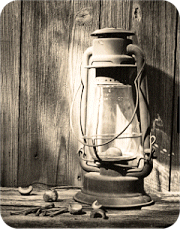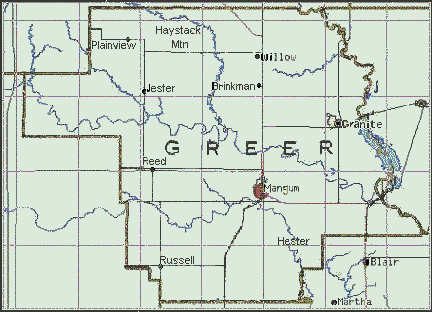
In 1927 Marvin Byrom worked on the gas line from the Sayre oil field to Mangum. Brinkman connected on to this line. Everyone was anxious to get the new heaters and kitchen ranges and make full use of this new fuel supply. Brinkman later got the electric high line into town. Now they had a good dependable supply of electricity. From about 1915, a dynamo driven by a gasoline engine furnished the electricity. This was owned and operated by W. D. Hall, a local businessman, and was available to all that wished to subscribe to it. It was an undependable and weak source of electricity when there were a lot of users.
For water, the people guttered their houses and caught the rainfall in cisterns. A man-made pond was constructed a few blocks south of Main and Broadway. Water was pumped from this site into a large concrete trough in the middle of the street at Main and Broadway. People could water their horses at this site. A lot of the town people had a milk cow that they staked out during the day to graze. They could lead the cow to this trough for water.
In the mid 1930's a water tower was constructed in Brinkman. Water was piped from a well on the W. T. Ross farm two and a half miles north and two miles east of Brinkman. Used oil field pipe was purchased for this waterline. This project did not prove as sucessful as hoped. The water line later developed a lot of leaks, the quantity and quality of the water was not as good as hoped. The bonds voted for the project also put a tax burden on the property owner that was difficult to pay. Mickey Little reports that a traveling salesman came to her father's drug store and said, "That's the first time I ever saw a water tower being built in a cemetery." Mr. Summers did not appreciate that statement, but outsiders could see what the local people did not want to admit. The town was dying even though it had a new school and was preparing to build a new gym.
The people of Brinkman thought that when the drought and depression abated, Brinkman would again prosper. Events were already in place where this would not happen. Better roads and cars made it easier for the people to go to larger towns where better prices and selections were available. WWII added to the demise of Brinkman.
The state highway department hard surfaced the road into Brinkman in 1942 when the hard surfaced U.S. Highway 283. This was a much needed improvement. The area received fifty-six inches of rain in 1941, and the road into town was almost impassable some of the time.
In the late teens, some of the rural homes had a carbide system where acetylene gas was manufactured from calcium carbide and water. This was used mostly for lights. In the late 1920s Skell Gas became available. The people could take a twenty-gallon container to Sayre and exchange for a full one. Underground butane tanks became available by 1937. A truck would com eand fill these 250 gallon tanks. This fuel was used for cooking and heating. Servel Electrolux Refrigerators were available that operated on this fuel. By the mid 1930s most farm homes had a "windcharger". It was a generator propelled by a wooden blade. It would furnish enough electricity for a radio and a few small light bulbs. The radio provided the family a good source of entertainment as well as news from outside the farm.
Electricity from the REA (Rural Electric Association) was available for much of the rural area in the early 1940s. Those who didn't get electricity by 1942 had to wait until after the war when copper wire again became available. This probably did more to improve the quality of life for rural America than any other thing. The farmers paid three dollars for up to thrity-five kilowatt hours of electricity. Many farmers could not use that much, especially if they already owned a gas refrigerator. Now most farm houses will use over 3,000 kilowatt hours a month.
Thanks to Kennith Kirby for Brinkman history.